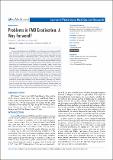Problems in FMD eradication : a way forward?
View/
Date
05/07/2018Grant ID
BB/K003801/1
BB/L004526/1
094898/Z/10/Z
Keywords
Metadata
Show full item recordAbstract
Foot and Mouth Disease Virus (FMDV) is one of the most commonly reported OIE-listed pathogens. FMDV is one of the most contagious mammalian viruses known to man: the virus is endemic in many developing countries causing substantial economic loses and the restriction of international trade in animals/animal products. The virus infects domestic animals (cattle, pigs, sheep, goats), but also a wide range of wild-life species, the latter forming reservoirs of disease. The need to diagnose FMDV infections (serotype/strain identification) and vaccine production/testing requires expensive, high disease security/containment facilities. Chemically inactivated (‘killed’) vaccines have been available for decades, but the huge genetic diversity of this virus (7 serotypes with 1000s of subtypes) and the need to periodically re-vaccinate animals to maintain protective levels of antibodies argue for the development of new vaccines. Indeed, in the early 1990s, on the basis of a cost-benefit analysis, the European Union replaced the policy of routine vaccination using the inactivated vaccine with disease control via mass-slaughter of infected and surrounding susceptible animals (plus vaccination in extremis). For various reasons mass-slaughter is unacceptable in many developing countries so in their case vaccination, in one form or another, is the only way forward. In the past few years there have been exciting developments in the production of new types of vaccine and many hold great prospects for improving disease control, but the thesis of this paper is that only the development of a new type of vaccine – live, attenuated, FMDV strains, offers the prospect of eradicating FMDV.
Citation
Tulloch , F , Luke , G A & Ryan , M D 2018 , ' Problems in FMD eradication : a way forward? ' , Journal of Veterinary Medicine and Research , vol. 5 , no. 5 , 1140 . < https://www.jscimedcentral.com/VeterinaryMedicine/veterinarymedicine-5-1140.pdf >
Publication
Journal of Veterinary Medicine and Research
Status
Peer reviewed
ISSN
2378-931XType
Journal item
Description
The authors would like to acknowledge the support of the Wellcome Trust (eGrantsref. No. 8048) and Biotechnology and Biological Sciences Research Council (BBSRC; Grants BB/K003801/1 and BB/L004526/1).Collections
Items in the St Andrews Research Repository are protected by copyright, with all rights reserved, unless otherwise indicated.

